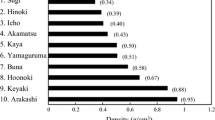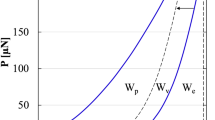Abstract
Transverse drying shrinkage was measured at microscopic and mesoscopic levels in poplar wood characterised by an increasing growth strain (GS), from normal to tension wood. Results show that: (a) the drying shrinkage, measured as a relative thickness decrease, was significantly higher for G-layer (GL) than for the other layers (OL), GL shrinkage was not significantly correlated with GS, and OL shrinkage was negatively correlated with GS. (b) In gelatinous fibre (G-fibre), lumen size increased during drying and this increase was positively related with GS, but in normal wood fibre, lumen size decreased during drying. These findings suggest that GL shrank outwards (i.e., its internal perimeter increases), so that its shrinkage weakly affected the total cell shrinkage and the mesoscopic shrinkage was controlled by the OL shrinkage which shrank inwards (i.e., its external perimeter decreases). (c) Measurements done on 7 × 7 mm² thin sections evidenced a negative correlation between transverse shrinkage and GS, significant in T direction but weak in R direction. These observations at both levels allow to discuss the contribution of GL to the mesoscopic shrinkage of tension wood.








Similar content being viewed by others
References
Arganbright DG, Bensend DW, Manwiller FG (1970) Influence of gelatinous fibers on the shrinkage of silver maple. Wood Sci 3:83–89
Barefoot AC (1963) Selected wood characteristics of young yellow-poplar. Part II: Shrinkage of normal and abnormal wood. For Prod J 13:443–448
Bosshard HH (1956) Über die anisotropie der holzschwindung. Holz Roh- Werkst 14:285
Chow KY (1946) A comparative study of the structure and composition of tension wood in beech (Fagus sylvatica L.). Forestry 20:62–77
Clair B, Thibaut B (2001) Shrinkage of the gelatinous layer of poplar and beech tension wood. IAWA J 22:121–131
Clair B, Ruelle J, Thibaut B (2003) Relationship between growth stresses, mechano-physical properties and proportion of fibres with gelatinous layer in chestnut (Castanea Sativa Mill.). Holzforschung 57:189–195
Clair B, Thibaut B, Sugiyama J (2005a) On the detachment of the gelatinous layer in tension wood fiber. J Wood Sci 51:218–221
Clair B, Gril J, Baba K, Thibaut B, Sugiyama J (2005b) Precautions for the structural analysis of the gelatinous layer in tension wood. IAWA J 26:189–195
Clarke SH (1937) The distribution, structure and properties of tension wood in beech (Fagus sylvatica L.). J For 11:85–91
Côté WAJ, Day AC, Timell TE (1969) A contribution to the ultrastructure of tension wood fibers. Wood Sci Technol 3:257–271
Fang C-H, Clair B, Gril J, Liu S-Q (2007) Growth stresses are highly controlled by the amount of G-layer in poplar tension wood. IAWA J (under review, submitted)
Fisher JB, Stevenson JW (1981) Occurrence of reaction wood in branches of dicotyledons and its role in tree architecture. Bot Gaz 142:82–95
Fournier M, Chanson B, Thibaut B, Guitard D (1994) Measurement of residual growth strains at the stem surface. Observations of different species (in French). Ann Sci For 51:249–266
Fujita M, Saiki H, Harada H (1974) Electron microscopy of microtubules and cellulose microfibrils in secondary wall formation of poplar tension wood fibers. Mokuzai Gakkaishi 20:147–156
Furuya N, Tatahashi S, Miyazaki M (1970) The chemical composition of the gelatinous layer from the tension wood of Populus euro-americana. Mokuzai Gakkaishi 16:26–30
Isebrands JG, Bensend DW (1972) Incidence and structure of gelatinous fibers within rapid-growing eastern cottonwood. Wood Fiber Sci 4:61–71
Jourez B, Riboux A, Leclercq A (2001) Comparison of basic density and longitudinal shrinkage in tension wood and opposite wood in young stems of Populus euramericana cv. Ghoy when subjected to a gravitational stimulus. Can J For Res 31:1676–1683
Kelsey KE (1963) A critical review of the relationship between the shrinkage and structure of wood. Commonwealth scientific and industrial research organization, Australia
Keylwerth R (1951) Die anisotrope Elastizität des Holzes und der Lagenholzer (Anisotropy of elasticity of wood and wood-based materials). VDJ–Forschungsheft 430, Düsseldorf (in German)
Kuo CM, Timell TE (1969) Isolation and characterization of a galactan from tension wood of American Beech (Fagus grandifolia Ehrl.). Svensk Papperstidn 72:703–716
Meylan BA (1972) The Influence of microfibril angle on the longitudinal shrinkage–moisture content relationship. Wood Sci Technol 6:293–301
Norberg PH, Meier H (1966) Physical and chemical properties of the gelatinous layer in tension wood fibre of aspen (Populus tremula L.). Holzforschung 20:174–178
Okumura S, Harada H, Saiki H (1977) Thickness variation of the G-layer along a mature and a differentiating tension wood fiber in Populus euramericana. Wood Sci Technol 11:23–32
Okuyama T, Yamamoto H, Yoshida M, Hattori Y, Archer RR (1994) Growth stresses in tension wood: role of microfibrils and lignification. Ann Sci For 51:291–300
Onaka F (1949) Studies on compression and tension wood. Wood research, Bulletin of the Wood research Institute, Kyoto University, Japan 24:1–88
Panshin AJ, de Zeeuw C (1980) Textbook of wood technology, 4th edn. Mc Graw-Hill Book Co., New York
Pilate G, Chabbert B, Cathala B, Yoshinaga A, Leplé J-C, Laurans F, Lapierre C, Ruel K (2004) Lignification and tension wood. C R Biol 327:889–901
Rasband WS (1997–2006) ImageJ. U.S. National Institutes of Health, Bethesda, Maryland, USA. http://rsb.info.nih.gov/ij/
Saiki H, Ono K (1971) Cell wall organization of gelatinous fibers in tension wood. Bull Kyoto Univ For 42:210–220
Sassus F (1998) Déformations de maturation et propriétés du bois de tension chez le hêtre et le peuplier : mesures et modèles. Ph.D. Thesis. ENGREF Montpellier, France (in French)
Skaar C (1988) Wood-water relations. Springer, Heidelberg
Timell TE (1969) The chemical composition of tension wood. Svensk Papperstidn 72:173–181
Timell TE (1986) Compression wood in gymnosperms. In: Biblioraphy, historical background, determination, structure, chemistry, topochemistry, physical properties, origin, and formation of compression wood, vol 1. Springer, Heidelberg
Wada M, Okano T, Sugiyama J, Horii F (1995) Characterization of tension and normally lignified wood cellulose in Populus maximowiczii. Cellulose 2:223–233
Wardrop AB (1964) The reaction anatomy of arborescent angiosperms. In: Zimmermann MH (ed) The formation of wood in forest tree. Academic, New York, pp 405–456
Washusen R, Ilic J (2001) Relationship between transverse shrinkage and tension wood from three provenances of Eucalyptus globulus Labill. Holz Roh Werkst 59:85–93
Yamamoto H, Abe K, Arakawa Y, Okuyama T, Gril J (2005) Role of the gelatinous layer (G-layer) on the origin of the physical properties of the tension wood of Acer sieboldianum. J Wood Sci 51:222–233
Yoshida M, Okuyama T (2002) Techniques for measuring growth stress on the xylem surface using strain and dial gauges. Holzforschung 56:461–467
Author information
Authors and Affiliations
Corresponding author
Rights and permissions
About this article
Cite this article
Fang, CH., Clair, B., Gril, J. et al. Transverse shrinkage in G-fibers as a function of cell wall layering and growth strain. Wood Sci Technol 41, 659–671 (2007). https://doi.org/10.1007/s00226-007-0148-3
Received:
Published:
Issue Date:
DOI: https://doi.org/10.1007/s00226-007-0148-3




